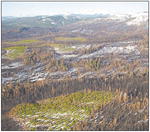|
Pinedale Roundup Volume 105, Number 21 - May 22, 2008 brought to you online by Pinedale Online
by Alecia Warren Sublette County landed a lucky break this week obtaining some public relations with international breadth, as a dozen globally renowned photographers scoured the area shooting close-ups of the problems locals have been clamoring for the state and national community to give more attention. Hailing from India, Spain, Germany, Mexico and across North America, the photographers represented the International League of Conservation Photographers (ILCP), a three-year-old coalition based in Arlington, Va., that uses its members’ artistry and journalistic integrity to document and spotlight urgent environmental situations around the world.
The project required the photographers to delve into the local maelstrom of wildlife and industry interests and quickly harvest images examining the effects of the vast local energy development. The prevailing goal was to produce photos allowing the world to take a close look at Sublette County and decide for itself what’s right or wrong. “We do know there are hundreds of thousands of photos of the wells and wildlife in the area already, and we aren’t attempting to recreate the wheel,” said American ILCP photographer Wendy Shatill, who organized the RAVE. “But because of the caliber of the world-class photographers who are members of ILCP, we can bring in different perspectives and at the same time bring in extra attention to the area.” The RAVE will end with an exhibit of 60 photos chosen from the week’s endeavors at the Jackson Museum of Wildlife Art on Friday.
We’re scattered throughout the valley to photograph what each of us feels is our specialty and skill.” Local conservationists led the photographers on a jaunt across the county early in the week. They jumped between the pristine and the industrial, including the Green River drainage, the Wyoming Range, Fremont Lake and Paradise Road, the dusty conduit to the anticline that weathers hundreds of truck trips every day. Shatill said she was surprised to see the dichotomy of wildlife activity like pronghorn migration occurring against the backdrop of drilling rigs.
Cristina Mittermeier, ILCP founder and executive director as well as a professional photographer from Mexico, said that no wilderness like Wyoming’s is left in Europe, or in most of the United States, for that matter. Hopefully people who peruse Friday’s exhibition will appreciate the value of the state’s natural resources, she said. “I think (the ILCP) is certainly in favor of preserving the Wyoming Range without making judgments on what the energy industry should look like,” Mittermeier said. “It’s just irreplaceable and unique to the U.S., and we should be really proud of that. So we have photographers from all over the world hoping to show that other countries simply don’t have gems like this one.” Jared White, spokesperson for the Wilderness Society, said he was glad to see the ILCP photographers making such an effort for the state. “We are starting to see hints of a public shift of opinion in Wyoming over the current direction and pace of energy development,” White said. “The images these photographers produce will help fuel that shift and open more eyes in Wyoming and beyond.” Usually a RAVE lasts two or three weeks, Shatill said, but this project suffered a shorter deadline because its last-minute creation prevented financial support from outside organizations. But even a few days in Pinedale revealed how passionately people care about the impacts of energy development and preserving wildlife, Shatill said. “It’s useful to look at the situation while there’s still something to salvage,” she said. “This is the time to do something, because once it’s gone, there’s no reason for us to come in — or for anybody to come in, for that matter. “It would already be a done deal. There would be nothing left.” See The Archives for past articles. Copyright © 2008 Pinedale Roundup All rights reserved. Reproduction by any means must have permission of the Publisher. Pinedale Roundup, PO Box 100, Pinedale, WY 82941 Phone 307-367-2123 editor@pinedaleroundup.com |




